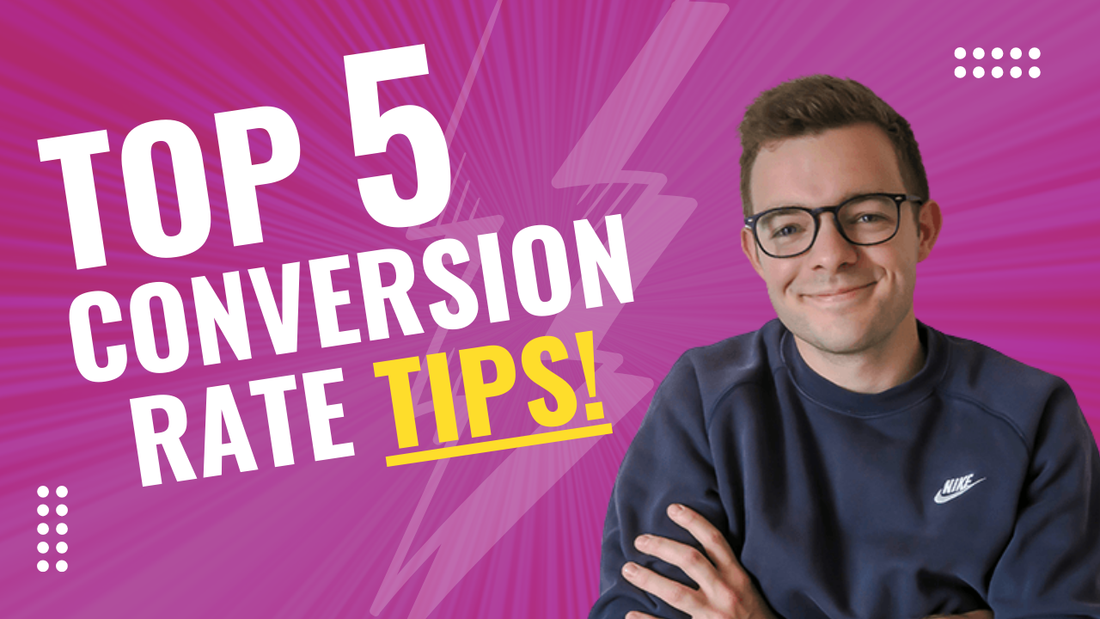You can also listen on:
Apple Podcasts / Spotify
On a recent episode of the Winning with Shopify podcast, Nick dove into a solo session tackling one of the biggest challenges for eCommerce store owners: how to convert more website visitors into paying customers. Nick broke down exactly what brands can do to address that all-too-common stat—99% of visitors don’t buy. From on-site fixes to deeper customer insights, here’s a recap of the practical advice he shared.
Conversion Rate: Context Is Everything
Nick began by dispelling the myth that there’s such a thing as a “good” or “bad” conversion rate. In his words, “Conversion rate is just one metric.” What matters more is how it correlates with other key stats like average order value and revenue.
In fact, some brands have seen conversion rates drop while revenue increases, simply by shifting focus to higher-ticket items. So, instead of obsessing over percentages, it’s more useful to look at the broader performance picture.
1. Use Reviews to Guide On-Site Messaging
Review content is one of the fastest ways to understand customers and build trust. Nick encouraged brands to read through all customer reviews and look for recurring themes—think “great value,” “fast delivery,” or “amazing customer service.”
These insights should shape what appears in a site’s top-line messaging—such as in the USP (Unique Selling Proposition) bar. Too often, Nick noted, these bars are filled with generic claims. Instead, they should reflect what actual customers care about.
He also suggested A/B testing different combinations (and quantities) of USPs to see what performs best—especially on mobile where space is limited.
2. Watch How People Use the Site (Microsoft Clarity)
One of Nick’s go-to tools is Microsoft Clarity. This free platform records real visitor behaviour on a site—showing where people click, scroll, and drop off.
Nick recommended:
-Watching sessions for both converters and non-converters
-Comparing desktop vs mobile journeys
-Looking for rage clicks (a sign that users are frustrated)
He shared a real-world example where a site’s mobile menu had a white background and a white “X” close button—making it nearly invisible. Fixing that one design flaw led to improved engagement and lower bounce rates.
3. Optimise Landing Pages for First-Time Visitors
A common mistake Nick sees? Brands designing homepages as if everyone lands there—when in reality, most first-time traffic enters through product or collection pages (via Google Shopping or SEO).
That means brands should:
-Tailor product/collection pages to introduce who they are
-Include trust-building elements on landing pages
-Use headers and visuals to immediately clarify what the brand offers
Returning visitors often go straight to the homepage—but new users need context the moment they arrive, wherever that may be.
4. Tailor Product Descriptions to Your Audience
Nick shared findings from testing across brands in different regions. German customers, for example, tend to prefer detailed, information-heavy descriptions. UK audiences want a balance, while US customers lean toward short, benefit-led summaries.
The key is to test and tailor content:
-Use bullet points, icons, and subheadings
-Avoid overwhelming visitors with too much text
-Offer enough clarity to answer key buying questions
He also advised against “read more” buttons on product descriptions, as they often go ignored. Instead, expand the full text and break it down into digestible chunks.
5. Talk to Your Customers (Literally)
Nick issued a challenge: phone the next 500 customers who place an order. Ideally, the call should come from the business owner or a senior team member.
The goal? Get real-time feedback on the buying experience:
-Was the site easy to use?
-Was this their first visit?
-What nearly stopped them from purchasing?
This kind of direct feedback can reveal insights no analytics platform can surface. Just don’t overreact to one-off opinions—focus on patterns across multiple conversations.
6. Make the Navigation Shoppable
Another common mistake Nick pointed out is the overuse of “Shop” dropdown menus. These often hide key categories behind extra clicks, which hurts conversions.
His advice:
-List core product categories in the top nav
-Avoid burying products under vague headings
-Optimise both desktop and mobile nav for clarity and speed
Navigation should make it easy for visitors to browse, not create friction. He also shared the example of removing “read more” toggles from FAQs and letting all answers show upfront—sometimes a small tweak like that can lift conversion rates.
Check out the full podcast episode here.
This episode was brought to you by Nick Trueman, Director of PPC & SEO Agency, Spec Digital.

